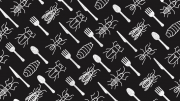In an increasingly wireless and connected world, we rely on our devices to communicate with each other constantly and autonomously on our behalf. Wherever there is a wireless connection, there is an antenna to send and one to receive data. The design of antennas and the networks that allow for their communication is crucial to the continuing use of the internet in our devices. Leading this charge is Ekram Hossain, a professor in the electrical and computer engineering program at the University of Manitoba working on improving wireless systems alongside University of Manitoba alumna, and PhD student at Queen’s University, Hayden Banting.
Antennas are one of the basic building blocks of electronics. They work by transforming an electrical signal, embedded in wires and circuitry, into waves in free space. They also work in reverse, receiving waves and transforming them into signals.
Antennas have become more diverse and sophisticated than the classic television antenna. Wireless networks have also become more sophisticated than the traditional wireless link of a cellphone’s connection to a tower.
In today’s smartphones, many different types of communication occur simultaneously. There are different antennas within the device for each type of connection, including Wi-Fi, GPS, Bluetooth and cellular. Each antenna needs to be individually designed and optimized for its desired function.
They are also used in an increasing array of devices: smartwatches, wireless headphones and medical devices worn on the body. Many of the safety features in cars rely on wireless systems. The broad range of uses for these devices requires a broad range of designs.
“The scope of these problems and challenges have really evolved quite recently,” said Banting.
More devices have become part of what’s known as the Internet of Things (IoT). The IoT refers to objects, often household ones, that are interconnected through wireless communications. These devices can “talk” to each other, sharing data for various purposes.
According to Hossain, one of the primary challenges in designing wireless networks to accommodate the IoT is that these signals are generally less reliable than wired channels, leading to transmission errors. Another challenge is working within the constraints of limited resources, like power and bandwidth. There are also security concerns to be addressed, since devices connected to the internet can be vulnerable to attacks and interference.
One of the goals of Hossain’s research is to optimize wireless systems to improve coverage, connectivity, capacity and reliability. Optimization is the mathematical search for the best balance of parameters to achieve the desired result within a set of constraints. It is the systematic process to find the best solutions in engineering and electronics.
Banting is working to optimize the design of antennas. Antenna design requires various parameters to be balanced, often without knowing the outcome of various tweaks and modifications before they are implemented. He relies on simulations to sort through a high number of potential solutions.
One strategy Banting is exploring uses the principles of biological evolution. An algorithm applies these principles to the design process to generate optimal antennas for a given purpose.
In nature, parental genes recombine to produce offspring with a unique set of genes that may or may not provide an advantage in their environment. Individuals in a population with advantageous genes are then favoured by natural selection. Over many generations, the population can acquire these advantageous traits to become more suited to their specific environment.
“Nature does a pretty good job of optimizing,” said Banting.
In Banting’s work, the parallel for the population of living organisms is a diverse set of potential solutions for antenna design. These designs vary across parameters like size, shape, placement and composition. Through simulation, they are then mixed and combined, like parental generations reproducing to create offspring.
In this way, engineers can simulate and test thousands of different trait combinations to reach a desired outcome. Here the success of an individual to suit their environment is analogous to how well the antenna meets its design specifications.
“It’s actually [the best] way to solve these really complex and challenging design problems.”





